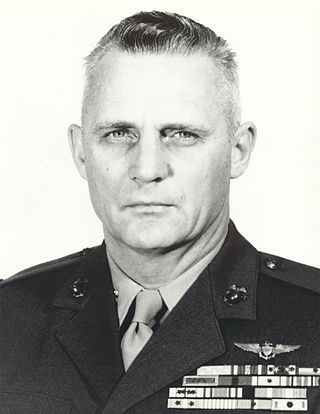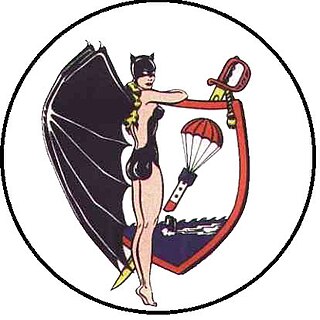Alan C. Carey | |
|---|---|
| Born | Orange County, California, U.S. |
| Occupation | Author, historian |
| Period | 1999-present |
| Genre | Military History |
| Notable works | We Flew Alone, 2nd Ed. Twin Mustang: The North American F-82 at War |
Alan C. Carey is an American author and historian who specializes in military aviation topics.
Carey was born in Orange County, California, to Robert Watson Carey (1926-2004) and Joyce Kathleen Haynes (1928-1991). He holds dual citizenship with the United States and Great Britain. Carey is a graduate of Southwest Texas State University (now Texas State University) with a master's degree in public administration and a bachelor's degree in history and political science.
Carey was born while his father was stationed at Marine Corps Air Station El Toro. His father served as an aviation radioman, air gunner, and navigator serving from World War II to the Vietnam War. Carey's childhood as a military dependent consisted of living in three states and three foreign countries before the age of five. His father's retirement and subsequent second career in the construction industry resulted in the family moving to several more states before settling in Texas in 1975. His writing career began as an intern with the Texas State Historical Commission in 1992 where he co-authored Historic Preservation Easements in Texas.
Like his father, a veteran of the Navy and Marine Corps, Carey enlisted in the military serving in the U.S. Marine Corps as a machine gunner/team leader and in the U.S. Army Reserve as a nuclear, biological, and chemical defense specialist and weapons instructor.
Carey's early interest in military aviation history stems from his father's career as an aviation radioman and air gunner with Navy Bombing Squadron 109 (VB-109) and reading the works of such military historians as Edwin P. Hoyt, Steve Birdsall, Barrett Tillman, and Samuel Eliot Morison.
In 1995, after researching VB-109's history, he was able to obtain the Distinguished Flying Cross and several additional Air Medals to his father's surviving crew members with the help of Congressman Lamar Smith (R). He is also noted for aiding veterans and families in a variety of issues related to military service. He began writing his first book, The Reluctant Raiders, after conducting research regarding his father's military service. Carey's early works traced relatively unknown aspects of military aviation primarily related to the Navy's use of the Consolidated B-24 Liberator and North American B-25 Mitchell.
Co-author non-fiction work
Chapters in a non-fiction work
Dogfights: Season 2, episode 17. Secret Weapons (3/14/08): Secret weapons of World War II: Appeared in the segment on American remote controlled airplanes of Operation Aphrodite.
Hunters In the Sky (2002): Appeared in infomercial for the documentary series on World War II aviation.

The North American B-25 Mitchell is an American medium bomber that was introduced in 1941 and named in honor of Brigadier General William "Billy" Mitchell, a pioneer of U.S. military aviation. Used by many Allied air forces, the B-25 served in every theater of World War II, and after the war ended, many remained in service, operating across four decades. Produced in numerous variants, nearly 10,000 B-25s were built, It was the most-produced American medium bomber and the third most-produced American bomber overall. These included several limited models such as the F-10 reconnaissance aircraft, the AT-24 crew trainers, and the United States Marine Corps' PBJ-1 patrol bomber.

The Consolidated B-24 Liberator is an American heavy bomber, designed by Consolidated Aircraft of San Diego, California. It was known within the company as the Model 32, and some initial production aircraft were laid down as export models designated as various LB-30s, in the Land Bomber design category.

The Consolidated C-87 Liberator Express was a transport derivative of the B-24 Liberator heavy bomber built during World War II for the United States Army Air Forces. A total of 287 C-87s were officially delivered from Consolidated Aircraft plant in Fort Worth, Texas. The plant also developed and delivered a USAAF flight engineer trainer designated as the AT-22. The AAF C-87A was an executive transport version of the C-87. The United States Navy VIP transport designated as the RY. The last development was a Navy contracted, single tail version with an extended fuselage. Built in San Diego, its USN designation was RY-3 and the AAF had order the design as the C-87C. Those were cancelled and allotted to a Royal Air Force VIP transport designated as the Liberator C.IX

The Douglas SBD Dauntless is a World War II American naval scout plane and dive bomber that was manufactured by Douglas Aircraft from 1940 through 1944. The SBD was the United States Navy's main carrier-based scout/dive bomber from mid-1940 through mid-1944. The SBD was also flown by the United States Marine Corps, both from land air bases and aircraft carriers. The SBD is best remembered as the bomber that delivered the fatal blows to the Japanese carriers at the Battle of Midway in June 1942. The type earned its nickname "Slow But Deadly" during this period.

The Lockheed Ventura is a twin-engine medium bomber and patrol bomber of World War II.

The Consolidated PB4Y-2 Privateer is an American World War II and Korean War era patrol bomber of the United States Navy derived from the Consolidated B-24 Liberator. The Navy had been using B-24s with only minor modifications as the PB4Y-1 Liberator, and along with maritime patrol Liberators used by RAF Coastal Command this type of patrol plane was proven successful. A fully navalized design was desired, and Consolidated developed a dedicated long-range patrol bomber in 1943, designated PB4Y-2 Privateer. In 1951, the type was redesignated P4Y-2 Privateer. A further designation change occurred in September 1962, when the remaining Navy Privateers were redesignated QP-4B.

Dunkeswell Aerodrome is an airfield in East Devon, England. It is located approximately 5 mi (8.0 km) north of the town of Honiton and 14 nautical miles northeast of Exeter. It is a busy civilian airfield with a mix of light aircraft, microlights and parachuting.

Kenneth Ambrose Walsh was a United States Marine Corps lieutenant colonel and a Medal of Honor recipient who was the fourth ranking USMC fighter ace in World War II with a record of 21 enemy planes destroyed. He also served in Korea during the first year of the Korean War and retired from the Marine Corps in February 1962.

This is the complete order of battle of Allied and Japanese forces during the Borneo campaign of 1945. As the campaign was fought in three geographically separate areas and the same air and naval units supported more than one of these battles the order of battle is split into the three areas.
As it turned out these operations were different from those that had gone before. The minefields were heavier and, for the first time in any Pacific campaign, man-made obstacles had been laid off the beaches.

Johnston Island Air Force Base is a former United States Air Force base on the Johnston Atoll in the United States Minor Outlying Islands, in the Pacific Ocean several hundred kilometers southwest of Hawaii. After its closure, it briefly operated as Johnston Atoll Airport, until that also closed in 2005.

Marine Fighting Squadron 132 (VMF-132) was a fighter squadron in the United States Marine Corps. The squadron, also known as "The Crying Red Asses", fought in World War II as a dive bomber unit during the Battle of Guadalcanal as part of the Cactus Air Force and later fought in the Central Solomon Islands. The squadron was decommissioned shortly after the end of the war but was reactivated in the Marine Air Reserve flying out of Floyd Bennett Field in Brooklyn, New York. They were again decommissioned sometime after 1958.

Marine Bombing Squadron 433 (VMB-433) was a United States Marine Corps medium bomber squadron during World War II. Nicknamed the "Fork-tailed Devils", the squadron flew PBJ medium bombers which were the naval version of the B-25 Mitchell. The squadron participated in combat operations in the Pacific Theater and was quickly deactivated after the war.

Patrol Squadron 24 (VP-24) was a Patrol Squadron of the U.S. Navy. The squadron was established as Bombing Squadron One Hundred Four (VB-104) on 10 April 1943, redesignated as Patrol Bombing Squadron One Hundred Four (VPB-104) on 1 October 1944, redesignated as Patrol Squadron One Hundred Four (VP-104) on 15 May 1946, redesignated Heavy Patrol Squadron (Landplane) Four (VP-HL-4) on 15 November 1946, redesignated Patrol Squadron Twenty Four (VP-24) on 1 September 1948, the third squadron to be assigned the VP-24 designation, redesignated Attack Mining Squadron Thirteen (VA-HM-13) on 1 July 1956, redesignated Patrol Squadron Twenty Four (VP-24) on 1 July 1959 and disestablished 30 April 1995.
Nukufetau Airfield is a former World War II airfield on the south-eastern side of Nukufetau on Motulalo Island in Tuvalu during the Pacific War.
VPB-109 was a Patrol Bombing Squadron of the U.S. Navy. The squadron was established as Bombing Squadron 109 (VB-109) on 2 August 1943, redesignated as Patrol Bombing Squadron 109 (VPB-109) on 1 October 1944, and disestablished on 12 October 1945.

VP-28 was a Patrol Squadron of the U.S. Navy. The squadron was established as Bombing Squadron 108 (VB-108) on 1 July 1943, redesignated Patrol Bombing Squadron 108 (VPB-108) on 1 October 1944, redesignated Patrol Squadron 108 (VP-108) on 15 May 1946, redesignated Heavy Patrol Squadron (Landplane) 8 (VP-HL-8) on 15 November 1946, redesignated Patrol Squadron 28 (VP-28) on 1 September 1948 and disestablished on 1 October 1969. It was the second squadron to be designated VP-28, the first VP-28 had that designation in 1944 and 1946.
This is a partial list of notable accidents and incidents involving the Consolidated-designed B-24 Liberator. Combat losses are not included except for some cases denoted by singular circumstances. Consolidated C-87 Liberator Express and PB4Y Privateers are also included.
Marine Attack Squadron 241 (VMA-241) was an aircraft squadron of the United States Marine Corps, known as the "Sons of Satan". The squadron was commissioned during World War II and took part in the Battle of Midway, sustaining 75% losses. It was extensively involved in combat while providing close air support during the 1944–1945 Philippines Campaign. The squadron, equipped with A-4 Skyhawk light attack aircraft, became part of the Marine Forces Reserve, based at Naval Air Station Los Alamitos, California, from 1946 until the 1960s.